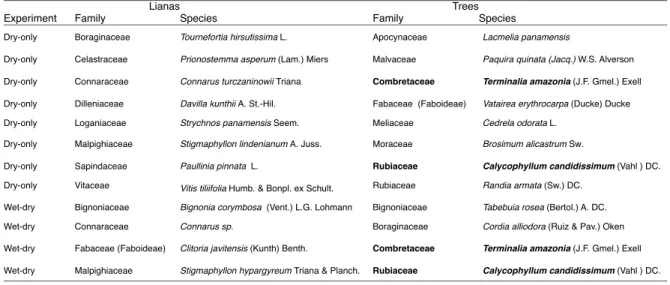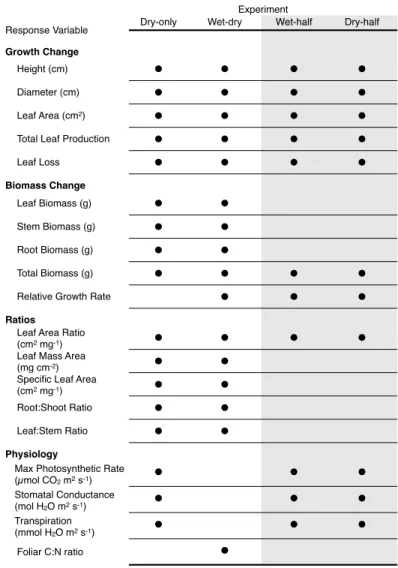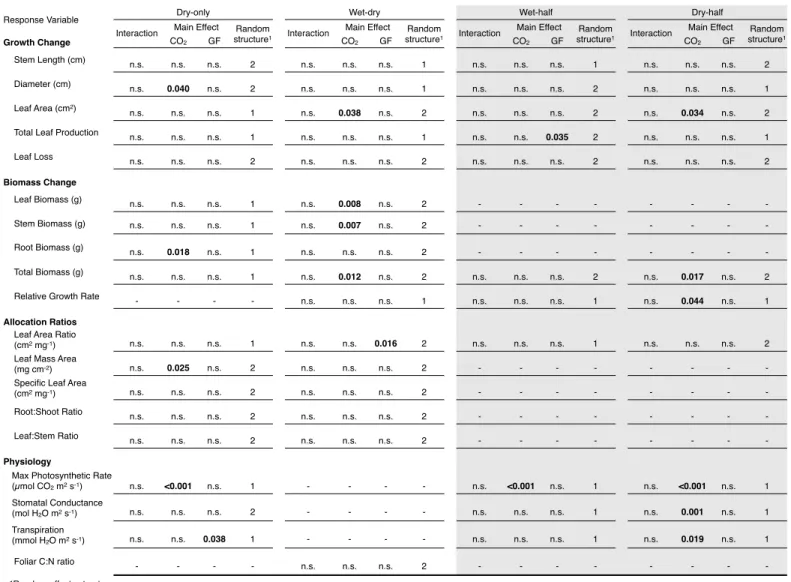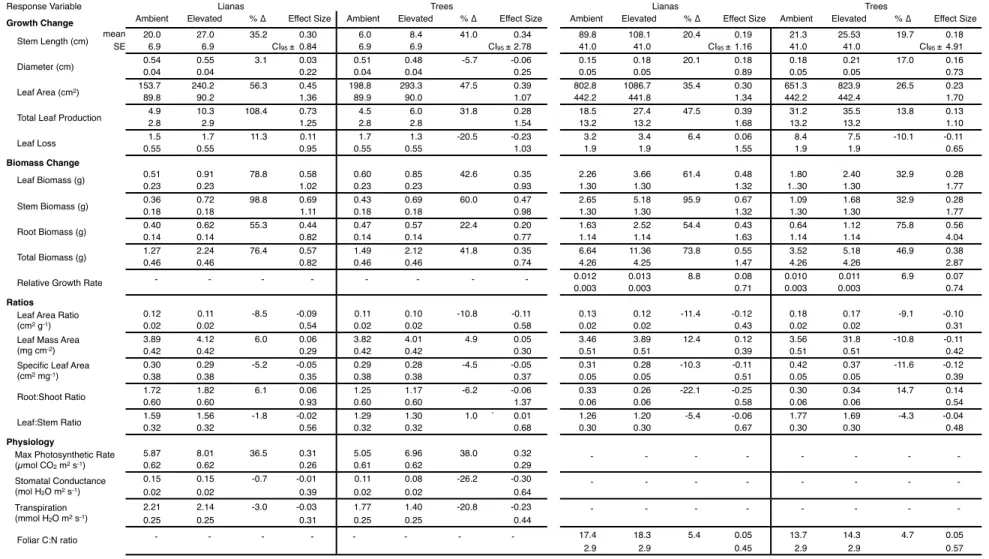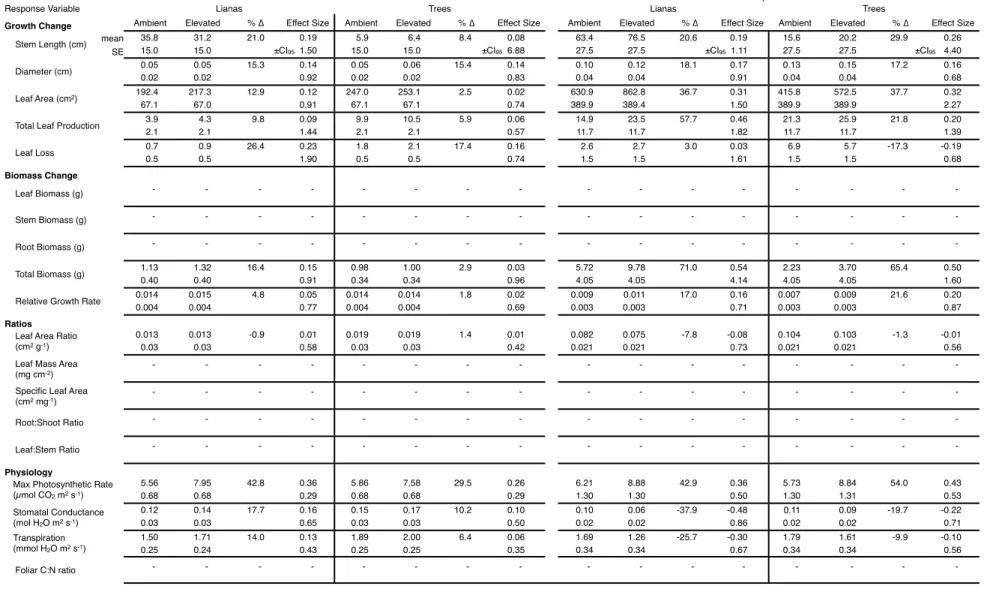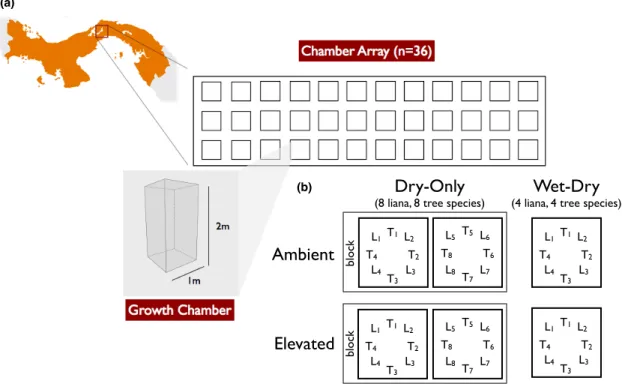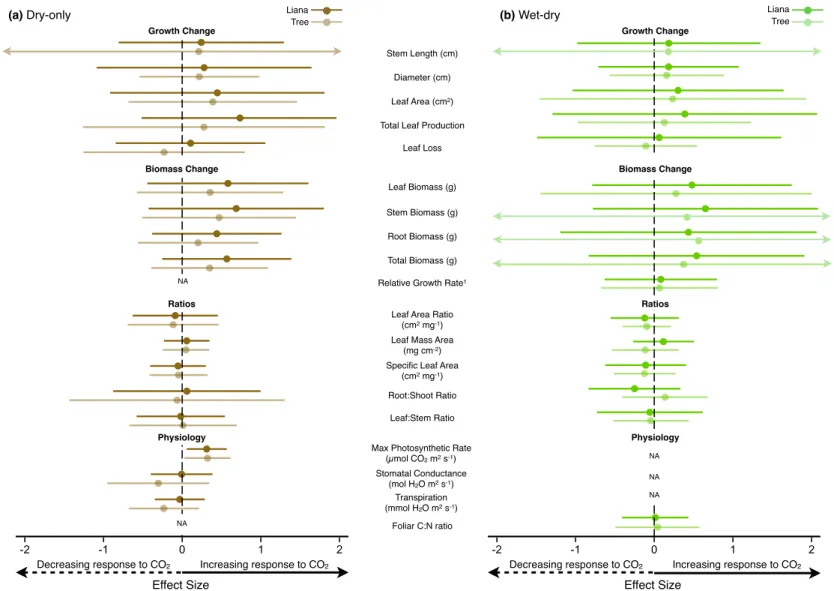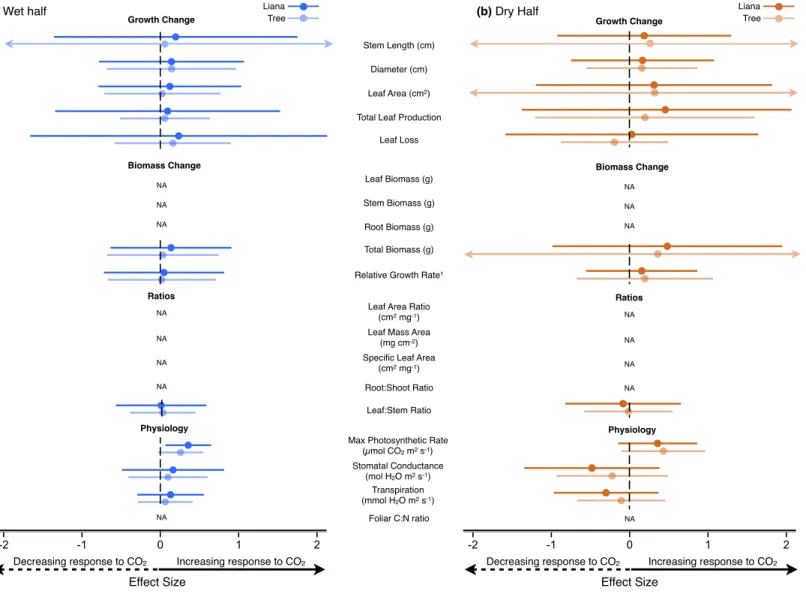Dave Karowe and Steve Bertman were both very supportive during my time in the BART program, and Nancy Tuchman for lending me equipment. A big thank you to all the assistants and interns who put up with the "intense heat/rain, humidity and stinging/biting insects" they were all warned about in my ads on ECOLOG, almost always without pay: Josh Dunlap, Belen Fadrique, Jose Luciani, Jake Malcomb, . Each of them supported and loved me through some of the hardest years of my life.
The NSF Graduate Research Fellowship, NASA Earth and Space Science Fellowship, and the Smithsonian Tropical Research Institute Predoctoral Fellowship all allowed me to travel and spend years abroad working full-time in the field and the laboratory. We as scientists are trained to be independent, able to assess and draw conclusions based on the merits of the evidence at hand. In the first experiments to directly compare the relative response of tropical liana and tree species to increased CO2, I found no significant differences between the two growth forms.
This method proved to be very accurate in distinguishing severe liana cover from liana-free cover in tree canopies, and quantified severe liana infestation from total canopy cover over a 600-ha tropical forest. The results of the experiments and the development of landscape-scale liana detection methods are key steps towards a full understanding of the mechanisms and extent of liana proliferation.
Introduction Introduction
No evidence that elevated CO 2 gives tropical lianas an advantage over tropical trees. In this chapter I describe two experiments I conducted in Panama testing the
While previous studies have shown that tropical lianas respond with increased growth and biomass to elevated CO2, no study has yet simultaneously tested the response of lianas and the trees growing beneath them. Without comparing the relative response of both growth forms to CO2 in the same experiment, we cannot prove whether lianas are more responsive to an increase in atmospheric CO2 than trees. The two studies presented in this chapter explicitly tested the response to elevated CO2 of seedlings of 11 tropical lianas and 10 tropical tree species growing together in soil and whether seasonal drought altered the response of any growth form.
The relative growth response of tropical lianas to elevated CO 2 does not depend on soil nutrient availability. Here I describe two multifactorial experiments that tested
While phosphorus availability has long been recognized as a key limitation of lowland tropical forest productivity, recent evidence suggests that nitrogen may also be in limited supply (Wright et al., 2011). As the global biogeochemical cycles of carbon, nitrogen, and phosphorus continue to change, increasing atmospheric CO2, higher rates of nitrogen deposition, and decreasing soil phosphorus levels may interact to favor tropical lianas over trees. In one experiment, seedlings of two lianas and two tree species were grown in pots with low and high nitrogen content in the soil.
In a second experiment, seedlings of three liana species were grown in pots with low and high phosphorus soil.
Mapping liana canopy cover across tropical forest landscapes using high-resolution imaging spectroscopy. This chapter presents the results of a new approach to
Due to the young age of the seedlings and high temperatures during the experiment only in drought, we applied. From these data we calculated the mean effect size (i.e., log response ratio) and 95% confidence interval of the effect size separately for liana and tree response to elevated CO2 according to the method of Hedges et al. The plant gas exchange response to elevated CO2 in this experiment is discussed below in the context of each half of the experiment due to the strong influence of seasonality.
During the wet half of the wet-dry season experiment, none of the growth or biomass. Elevated CO2 caused significant increases in maximum photosynthetic rate in both the wet and dry halves of the wet-dry season experiment, with a 36.0% increase in the wet half and a 48.2 % in the dry half. This hypothesis has been suggested as one of the underlying mechanisms explaining the reported growth of liana (Mohan et al., 2006; Körner, 2009; Schnitzer & Bongers, 2011).
Note: The Wet-half and Dry-half experiments are subsets of the Wet-Dry experiment. Note: The Wet-half and Dry-half experiments are subsets of the Wet-Dry experiment. Effect size response to CO2 for growth variables, biomass variables, response variable ratios and physiological variables in the a) wet half and b) dry half of the wet–dry season experiment.
During the dry-only experiment, a VWC probe (CS616, Campbell Scientific) was used to sample moisture in the top 20 cm of soil in each chamber weekly (Table S2.1). We used coefficients from this best-fit model to predict the biomass at the beginning and end of the wet season of the plants grown in the experiments. We used the coefficients from this best-fitting model to predict the initial biomass of the plants grown in the experiments.
Most of the significant differences between ambient and elevated CO2 occurred at the leaf level when pooled across all P treatments. Similarly, high soil organic content may have led to high rates of nitrification with loss of of the resulting gas (Koehler et al., 2009), but we found lower net nitrification rates in the high N compared to the low N treatment (data not shown). The contrasting chemical and structural properties of leaves between lianas and trees result in documented differences in the reflectance spectra of growth forms.
The study site is a mainland peninsula of the Barro Colorado Natural Monument in the Republic of Panama (Figure 4.2). We applied the optimal SVM model to the full VSWIR image range of the study site. 2.8%±4.2%) in the removal plots and the agreement between classified and measured liana cover in the control plots support the validity of the optimal SVM model.
A correlation was discovered between the topography of the site and the presence of severe liana cover.
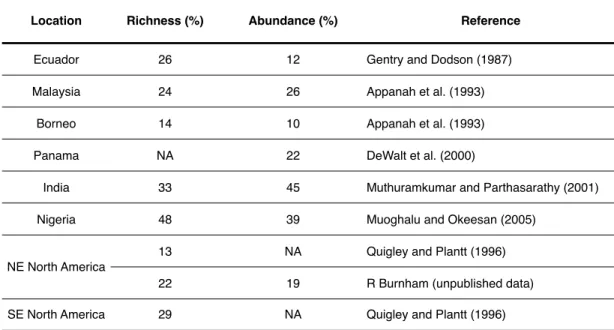
More empirical work, including species-specific tests of elevated CO2, is needed to form a mechanistic understanding of the processes driving lianas to become more abundant, relative to trees. Second, I developed new methods to detect liana canopy cover at the landscape scale, which include the tools to verify, quantify and monitor liana canopy cover in a spatially explicit manner (Chapter 4). Large-scale, high-resolution maps of liana canopy cover can be used to investigate the temporal and spatial ecology of lianas and, when combined with field and other remote sensing data, document their effects on ecosystem function at an unprecedented scale.
Indeed, investigations into the mechanistic understanding of growing lianas, as well as recordings of temporal demographic changes, should be carried out at the species level. These two approaches, experimentation and field recordings, can inform each other, with census demographic data used in selecting species for experimentation, and experimental results used to design field studies that test these mechanisms in natural systems. .
The relative growth response of tropical lianas to elevated CO 2 does not depend on soil nutrient availability. Ecological processes do not occur in isolation, therefore I
Mapping liana canopy cover across tropical forest landscapes using high-resolution imaging spectroscopy. Studies documenting the relative increase of tropical
Increased CO2 and climate change are a subset of the dramatic effects humans are having on the tropical biosphere. While deforestation rates have slowed in many parts of the Amazon, this decline has been more than offset by dramatic increases in other tropical regions (Hansen et al., 2013). However, proposals are being seriously considered which will simultaneously solve the apparently difficult problems of deforestation and climate change.
Reduced Emissions from Deforestation and Degradation (REDD+) seeks to stimulate tropical forest conservation by linking carbon emitters with parties able to reduce forest carbon losses (Stickler et al., 2009). The effectiveness of REDD+ will depend in part on the ability of tropical ecologists to accurately understand and monitor the dynamics and growth of tropical forests. In: Treetops at Risk: Global Canopy Ecology and Conservation Challenges (M. Lowman et al. eds.) pp. 177–193.
Hansen MC, Potapov PV, Moore R, et al. 2013) High-resolution global maps of 21st century forest cover change. -Nielsen J, Kollmann J, Pena-Claros M (2009) Effects of liana load, tree diameter and distances between conspecifics on seed production in tropical hardwood trees.
